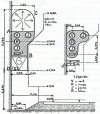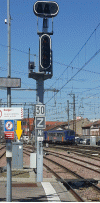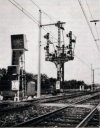My daughter is currently on the afternoon AVE Madrid-Avignon(-Marseille) which was misrouted at the Avignon triangle and is currently sat North of Orange (there are loops and crossovers there, first after the junction!) waiting for the train to reverse and head back South (minimum +60 so delay repay kicks in). Edit - which it now is!
Described by the crew as a hardware failure.
So - how does the TVM cab signalling inform the driver of the route that is set, as opposed to the speed? Obviously at TGV speeds you can't check the points are set! A quick glance at a well-known, never inaccurate, online source doesn't say. Any SNCF experts here?
Thanks in advance.
Described by the crew as a hardware failure.
So - how does the TVM cab signalling inform the driver of the route that is set, as opposed to the speed? Obviously at TGV speeds you can't check the points are set! A quick glance at a well-known, never inaccurate, online source doesn't say. Any SNCF experts here?
Thanks in advance.




